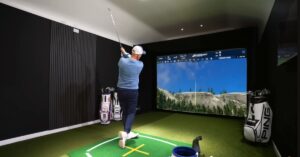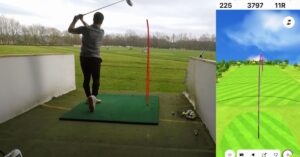How Does Putting Work On Golf Simulator? [Ultimate Guide]
Putting in a golf simulator typically works by using a sensor or camera system to track the movement and impact of the golf ball.
The simulator software then uses this information to determine the trajectory and speed of the ball, as well as any spin or other factors that may affect its movement.
The simulator will then display the ball’s flight on the screen and provide feedback on the shot, such as the distance and direction of the putt and any adjustments that may be needed to improve the shot.
Some simulators also have the feature of providing green reading and break simulation to give a more realistic experience.
![How Does Putting Work On Golf Simulator? [Ultimate Guide] 1 How Does Putting Work On Golf Simulator](http://giftedgolfers.com/wp-content/uploads/2023/01/How-Does-Putting-Work-On-Golf-Simulator-1024x536.jpg)
How to use drills and routines to improve your putting skills and performance?
To improve your putting skills and performance using drills and routines, you can follow these steps:
Start with a basic alignment drill
Place a club or a straight edge on the ground to use as a guide for your putter alignment. Practice setting up the ball with your putter square to the target line.
Use a gate drill
Set up two tees or small cones on the ground, one on either side of the hole, to simulate the gate the ball needs to pass through.
Practice hitting putts that pass through the gate without touching either the tee or cone.
Practice speed control
Set up a series of tees or cones at different distances from the hole and practice hitting putts to each one. This will help you learn to control the speed of your putts.
Use a mirror
Set up a mirror behind the hole and practice your stroke. This will allow you to see your body position and how your putter moves through the stroke.
Practice regularly
Consistency is key. Try to practice your putting routine regularly to improve your putting skills and performance.
Use a putting green or a dedicated putting mat
Putting greens or dedicated putting mats are designed to mimic the speed and slope of real greens, which will help you develop a better sense of how your putts will react on the course.
Use a training aid
There is a variety of putting aids available that can help you with alignment, stroke, and distance control. Try a few out to see which one works best for you.
Remember, putting is a complex skill requiring much practice and patience. It takes time to develop a consistent and reliable putting stroke, so be patient with yourself and keep practicing.
Step-by-step instructions for setting up the simulator and configuring it for putting practice
![How Does Putting Work On Golf Simulator? [Ultimate Guide] 2 setting up the simulator](http://giftedgolfers.com/wp-content/uploads/2023/01/image-67.png)
Golf simulators are a great way to practice and improve your putting skills, even when you can’t make it to the course.
With the right hardware and software, you can set up a golf simulator in your home and practice your putting whenever you want.
This step-by-step guide will show you how to set up and configure a golf simulator for putting practice, so you can work on your form, aim, and putting accuracy.
Verify Hardware and Software Requirements
Before setting up your golf simulator, make sure that your computer meets the minimum hardware and software requirements to run the simulator.
This typically includes a computer with a sufficient graphics card and the simulator software itself.
It’s also important to ensure that your computer has enough space to run the simulator and store the course data.
Download and Install Simulator Software
Once you’ve confirmed that your computer meets the requirements, download and install the simulator software on your computer, this should include instructions on how to set up and configure the software.
Launch Simulator and Familiarize yourself with Interface
After the software is installed, launch the simulator and familiarize yourself with the interface.
This may include adjusting settings such as screen resolution, graphics quality, and other options.
Take some time to explore the simulator’s features and options to get the most out of your practice sessions.
Configure Simulator for Putting Practice
Set up the simulator for putting practice. This may include configuring the course, adjusting the difficulty level, and selecting the type of putting you wish to practice (e.g. straight, breaking, uphill, downhill, etc.).
You can also adjust settings such as ball speed, spin, and trajectory to suit your individual needs.
Start Practicing Your Putting
Begin practicing your putting by hitting the ball on the screen with your mouse or other input devices.
Take note of the ball’s trajectory, speed, and spin, and make adjustments as necessary to improve your putting skills.
Repeat the process and adjust the settings
Repeat the process as often as you wish, adjusting the settings and practicing different types of putting as you improve.
Use a Putting mat and a real putter
It is also helpful to use the simulator with a putting mat that simulates a real green surface and use a real putter.
This will help you get more realistic feedback and improve your putting skills more effectively.
Make use of an in-built camera, video analysis, and statistics
Many simulators have in-built cameras and video analysis tools that can help you analyze your putting form and identify areas for improvement.
Utilize these features to understand your putting stroke better and make adjustments as needed.
Use Training Aids
Consider using training aids like putting mirrors and alignment rods to help you work on your form and aim.
These tools can help you improve your alignment and aim and can make a big difference in your putting accuracy.
Have Fun and Enjoy!
Putting practice can be a great way to improve your golf game and enjoy some friendly competition with friends and family. Remember to have fun and enjoy the process of improving your putting skills.
Tips and exercises for improving your putting technique and fundamentals using a golf simulator
![How Does Putting Work On Golf Simulator? [Ultimate Guide] 3 putting technique and fundamentals using a golf simulator](http://giftedgolfers.com/wp-content/uploads/2023/01/image-68-1024x623.png)
Golf simulators are a great tool for improving your putting technique and fundamentals.
With a simulator, you can practice your putting in a controlled environment and get instant feedback on your form and performance.
These tips and exercises will help you make the most of your time on the simulator and improve your putting skills quickly and effectively.
Focus on alignment
One of the most important aspects of putting is alignment. Make sure to take the time to align yourself properly to the target, and use the simulator’s alignment tools to help you check your alignment.
Practice different types of putts
Practice different types of putts, including straight, breaking, uphill, and downhill putts.
This will help you develop the skills you need to handle any type of putt on the course.
Use the camera and video analysis
Use the simulator’s camera and video analysis tools to analyze your putting form and identify areas for improvement.
Look for things like head movement, hand position, and body alignment, and make adjustments as needed.
Work on your speed control
Speed control is critical when it comes to putting. Use the simulator to practice hitting putts at different speeds and learn how to control the speed of your putts.
Take time for visualization
Before hitting each putt, take a moment to visualize the ball’s path and the point where you want it to land.
This can help you develop a clear picture of what you want to achieve and make it more likely that you’ll achieve it.
Practice with a metronome
Using a metronome can help you develop a consistent tempo and rhythm in your putting stroke.
Set the metronome to a comfortable tempo and practice hitting putts in time with the metronome.
Use a putting mirror
A putting mirror can be a helpful tool for identifying and correcting any issues with your putting stroke.
Place the mirror next to the ball and check your alignment and form in the mirror before hitting each putt.
Work on your aim and distance control
Aim and distance control are critical when it comes to putting. Use the simulator to practice hitting putts from different distances and learn how to control the distance of your putts.
Work on your green reading
Use the simulator to practice your green reading skills. Try to read the break and slope of the green, and adjust your aim and speed accordingly.
Keep track of your progress
Keep a record of your progress and track your putting statistics, including your putts per round, average putt distance, and percentage of putts made. This will help you identify areas of improvement and track your progress over time.
Tips for transferring your simulator-honed putting skills to the course
Here are some tips for transferring your simulator-honed putting skills to the course:
Practice visualization
Visualize yourself executing the same putting stroke and routine on the course that you used on the simulator. This will help you transfer the skills you learned in the simulator to the course.
Focus on the fundamentals
The simulator can provide detailed information about your putting stroke. Still, it’s important to remember that the fundamentals of your putting, such as grip, stance, and alignment, are still crucial for success.
Use the same routine
Use the same pre-shot routine on the course that you used on the simulator. This will help you maintain consistency and a clear mind when putting on the course.
Monitor your progress
Use the information you received from the simulator to monitor your progress on the course. Compare your putting statistics from the simulator to your putting on the course.
Practice in similar conditions
If the simulator allows you to practice in different weather conditions, try to practice in similar conditions to the ones you will face on the course. This way, you will be more prepared.
Use the simulator as a compliment
Remember that the simulator is a tool to help you improve your game. It’s not a replacement for actually playing on the course. Use it to complement your practice, not to replace it.
Practice regularly
Putting is a complex skill that requires a lot of practice and patience. It takes time to develop a consistent and reliable putting stroke, so be patient with yourself and keep practicing.
FAQs
Here, you will find answers to some of the most common questions about using a golf simulator to improve your putting skills. So, if you want to improve your putting skills and performance, read on for some helpful tips and information.
How does a golf simulator measure putting performance?
A golf simulator typically uses a combination of sensors and cameras to track the movement and impact of the ball.
These sensors can measure ball speed, spin, and trajectory, which can provide detailed information about a player’s putting performance.
Can a golf simulator help me improve my putting?
Yes, a golf simulator can be valuable for improving your putting. A simulator can help you identify and correct any issues you may have by providing detailed information about your putting stroke and performance.
Additionally, a simulator can help you develop a more consistent and reliable putting stroke by allowing you to practice in a controlled environment.
Can a golf simulator simulate different types of greens?
Yes, many golf simulators can simulate different types of greens with varying speeds and slopes.
This allows players to practice on various surfaces and conditions, which can help them develop a better sense of how their putts will react on the course.
Is it accurate to play putting on a simulator?
The accuracy of putting on a simulator will depend on the quality and capabilities of the simulator.
High-end simulators use advanced sensors and cameras that can accurately measure ball speed, spin, and trajectory. However, lower-end simulators may not be as accurate.
Can I use my own putter on the simulator?
Yes, you can use your own putter on most golf simulators. Some simulators may require you to use a special sensor or adapter to track your putting performance, but most will work with any standard putter.
Can I play with my friends on a putting simulator?
Yes, many golf simulators have multi-player capabilities, allowing you to play and compete with friends.
Some simulators even have online communities where you can join and compete with players from around the world.





![How Accurate Are Golf Simulators For Distance? [8 Tips To Boost Simulator Experience] How-Accurate-Are-Golf-Simulators-For-Distance](https://giftedgolfers.com/wp-content/uploads/2023/01/How-Accurate-Are-Golf-Simulators-For-Distance-300x157.jpg)
